|
|
1. Job 9:9: El hizo la Osa (Arturo) , el Orión y las Pléyades,Y los lugares secretos del sur;
Arturo (estrella)
De Wikipedia, la enciclopedia libre
«Arcturus» redirige aquí. Para la banda noruega de black metal/avant-garde, véase Arcturus (banda).
| Arturo |
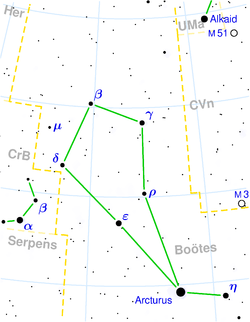
Ubicación de Arturo en la constelación de Boötes. |
Datos de observación
(Época J2000.0) |
| Constelación |
Boötes |
| Ascensión recta (α) |
14h 15m 39,67s |
| Declinación (δ) |
+19° 10′ 56,7″ |
| Mag. aparente (V) |
−0,04 |
| Características físicas |
| Clasificación estelar |
K1.5III |
| Masa solar |
1 – 1,5 M☉ |
| Radio |
(25,7 ± 0,3[1] R☉) |
| Índice de color |
1,24 (B-V)
1,22 (U-B) |
| Magnitud absoluta |
−0,29 |
| Luminosidad |
215[2] L☉ |
| Temperatura superficial |
4.290 K |
| Metalicidad |
20 – 50% del Sol |
| Variabilidad |
Posible |
| Edad |
> 4,6 × 109 |
| Astrometría |
| Mov. propio en α |
−1093,45 mas/año |
| Mov. propio en δ |
−1999,40 mas/año |
| Velocidad radial |
−5,2 km/s |
| Distancia |
36,7 ± 0,3 años luz |
| Paralaje |
88,78 ± 0,68 mas |
| Referencias |
| SIMBAD |
enlace |
| Otras designaciones |
| Aramec, Abramech, α Boötis, 16 Boötis, HD 124897, HR 5340, BD+19°2777, GCTP 3242.00, GJ 541, LHS 48, y HIP 69673 |
Arturo o Arcturus (Alfa Bootis / α Boo / 16 Bootis) es la tercera estrella más brillante del cielo nocturno con una magnitud visual de -0,04, después de Sirio (α Canis Majoris) y Canopus (α Carinae); considerando juntas las dos componentes principales de Alfa Centauri, que no se pueden resolver a simple vista, Arturo pasa a ser la cuarta estrella más brillante. Se trata, por lo tanto, de la estrella más brillante del hemisferio celeste norte. Su constelación es Boötes, «El Boyero». Se encuentra en la Nube Interestelar Local.
[editar] Etimología e historia

Forma de encontrar a Arturo en el cielo, a partir de la Osa Mayor.
El nombre de Arturo proviene del griego antiguo Αρκτοῦρος (Arcturus), «el guardián del oso» y está relacionado con su proximidad a las constelaciones de la Osa Mayor (Ursa Major) y la Osa Menor (Ursa Minor). En árabe recibe el nombre de As-Simak ar-Ramih (السماك الرامح), traducido por «la pierna del que porta la lanza» o «el noble que porta la lanza». Este nombre, romanizado en el pasado, ha dado lugar a los nombres de Aramec y Azimech, hoy obsoletos. Otro nombre árabe es Al-Harith as-Sama' (الحارس السماء), «el que guarda los cielos».[3] [4]
En el antiguo Egipto parece que era conocida como Smat, «el que reina» o «el que gobierna», así como Bau, «el que viene».[5] Un calendario astronómico egipcio del siglo XV a.C. asocia a Arturo con Antares (α Scorpii) en una inmensa figura celestial llamada Menat. Para algunos autores era uno de los astros de culto en los templos del Nilo y en el templo de Venus en Ancona (Italia).[6]
En astronomía hindú corresponde a la nakshatra —una de las mansiones en las que se divide el cielo— de Svātī; allí también se la llamaba Nishṭya, «fuera», posiblemente por su localización boreal lejos del zodíaco. En China era conocida como Ta Kiō, «el gran cuerno», mientras que cuatro pequeñas estrellas cercanas eran Kang Che, «el lago de la sequía».[6]
En aragonés se la llama Petarruego, probablemente una denominación formada por el verbo petar y por el antiguo adjetivo royo («rojo»).
[editar] Características físicas

Tamaño de Arturo en comparación con el Sol.
Arturo es una gigante naranja de tipo espectral K1.5III, distante 36,7 años luz del Sistema Solar, la segunda estrella gigante más próxima después de Pólux (β Geminorum). Con una temperatura superficial de 4290 K, es visualmente 113 veces más luminosa que el Sol; pero si se considera la radiación que emite en el infrarrojo, su luminosidad es casi el doble, 215 veces mayor que la solar. Su radio, obtenido a partir de la medida de su diámetro angular (0,0210 segundos de de arco), es 25,7 veces más grande que el radio solar. Su masa es aproximadamente un 50% mayor que la del Sol y se piensa que en su núcleo interno ya ha comenzado la fusión nuclear de helio en carbono. Emite rayos X débiles, lo que sugiere que posee actividad magnética —pudiendo tener una «corona oculta»—, algo inusual en una estrella de sus características.[2] Se sospecha que puede ser una estrella variable, habiendo recibido la denominación de NSV 6603.[7]
La velocidad relativa de Arturo respecto al Sol, mayor que la de otras estrellas brillantes, así como su baja metalicidad —aproximadamente un 28% de la solar—, sugieren que puede ser una estrella vieja de Población II y un miembro del disco grueso galáctico.[8] [9] Forma parte de un grupo de 53 estrellas que se mueven conjuntamente a través de nuestra galaxia y que recibe el nombre de «Grupo de Arturo».[10] Una interesante teoría sostiene que Arturo, así como el resto de estrellas que forman su grupo, se han formado más allá de los confines de la Vía Láctea; la edad de algunos de sus miembros puede remontarse hasta los 10.000 - 12.000 millones de años, lo que implicaría que pueden provenir de una galaxia satélite absorbida en el pasado por nuestra propia galaxia.[11]
[editar] Véase también
http://es.wikipedia.org/wiki/Arturo_(estrella)
|
|
|
|
|
====== El Universo y Arturo ===== Los griegos llamaron Arcturus o Arturo a la estrella más brillante de la constelación del Pastor. Es la estrella que figura sobre su rodilla izquierda. Arturo era hijo de Zeus y de Calisto. Hera, la celosa esposa de Zeus, convirtió a Calisto en una osa. Arturo fue a cazar osos y, ajeno al hechizo, estuvo a punto de matar a su madre, Zeus lo evitó y la elevó al cielo, donde se convirtió en la "Ursa Major", la Osa Mayor. Arcturus significa "El Guardián del Oso" ----    ------- Arturo aparece, a veces, guiando a los perros de caza de la cercana "Canes Venatici" y siguiendo a los osos de la Osa Mayor y de la Osa Menor.  Los astrónomos dicen que Arcturus tiene un gran "movimiento propio". ------------- Si se unen las tres estrellas del brazo de la Osa y se sigue un arco se llega a Arturo que, como siempre, está cerca de Virgo. Los astrónomos dicen que Arcturus tiene un gran "movimiento propio". ------------- Si se unen las tres estrellas del brazo de la Osa y se sigue un arco se llega a Arturo que, como siempre, está cerca de Virgo.  ------ Arturo está a treinta y siete años luz de la Tierra y es uno de los astros brillantes más cercanos y la cuarta más brillante de nuestro firmamento. La aparición de Arturo al atardecer significa el comienzo de la Primavera y su desaparición el comienzo del Otoño. (un año luz son unos 10 TRILLONES(usa) de kilómetros. Nuestra galaxia, la Vía Láctea, con una anchura de 150.000 años luz, contiene 100.000 millones de estrellas y unos 200.000 soles. Nuestro Sol se encuentra a unos 33.000 años luz del centro de la galaxia en su tercer brazo, llamado Orión)  ----- Arcturus destella una luz entre amarilla y anaranjada, lo que significa que es una gigante roja que va aumentando de tamaño según se acerca el final de su existencia. Su diámetro es 27 veces el del Sol, aunque su masa es similar, y emite una cantidad de luz cien veces superior a la que emite el Sol, que solo se encuentra en la mitad de su vida y a 150 millones de kilómetros de la Tierra. Dentro de unos 5.000 Mill. años, el Sol ofrecerá una imagen similar a la de Arturo y la vida en la Tierra habrá sido abrasada. Es posible que Arturo tuviera antaño un planeta que albergaba vida. ------------- -------- En España, durante el mes de abril, Arturo está sobre nuestras cabezas, en su cenit. (Norte)  (Sur) ----------- Los gráficos corresponden, aproximadamente, a la situación de las estrellas sobre España entre las 20 y las 24 horas --- Si quieres ver el firmamento que tenemos en España durante el mes de abril pulsa en: Las estrellas en ABRIL ------------------- Y si quieres ver el de Diciembre o Enero pulsa en: Las estrellas en DICIEMBRE -------- Las estrellas en ENERO -------- Otra estrella muy especial de Primavera, Verano, Otoño e Invierno y el milenio ------------ Si quieres iniciarte en los secretos del Universo pulsa en: El Origen del Universo solo para los que hayan visitado la página de ARCTURUS ----- El origen del universo según la mitología griega La Mitología y la Creación (Sur) ----------- Los gráficos corresponden, aproximadamente, a la situación de las estrellas sobre España entre las 20 y las 24 horas --- Si quieres ver el firmamento que tenemos en España durante el mes de abril pulsa en: Las estrellas en ABRIL ------------------- Y si quieres ver el de Diciembre o Enero pulsa en: Las estrellas en DICIEMBRE -------- Las estrellas en ENERO -------- Otra estrella muy especial de Primavera, Verano, Otoño e Invierno y el milenio ------------ Si quieres iniciarte en los secretos del Universo pulsa en: El Origen del Universo solo para los que hayan visitado la página de ARCTURUS ----- El origen del universo según la mitología griega La Mitología y la Creación
|
|
|
|
|
Sirius and Orion Over Washington
The Congress of Isis and Osiris just so happens to happen above... Congress.
Washington D.C. and many of it's buildings and monuments are laid out according to the cardinal directions with the streets running due NS and EW.
In the map of Washington D.C. below, due east is up and the star chart shows the constellation of Orion rising due east over Washington D.C., as it has done every day for the past two hundred years.
Orion's belt points towards Sirius, the brightest star in the sky, and while Orion is rising and low on the eastern horizon, Orion's belt is vertical, pointing to Sirius below.
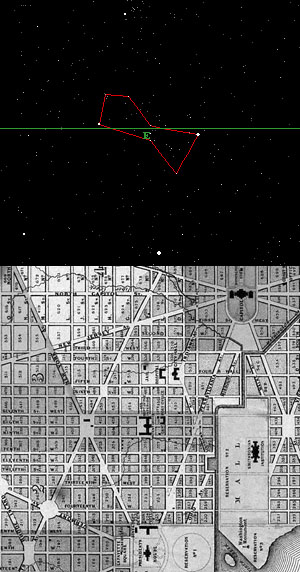
In relation to the fixed stars, the sun rises later each day due to the rotation of the earth around the sun.
The sun rises just after Sirius at the latitude of Washington D.C. on August 15. This is known as the heliacal rising of Sirius. Prior to this time of year, the sun is above or too close to the horizon for the rising of the star to be visible.
Ancient Egyptians based their calendar on the heliacal rising of Sirius, which signaled the onset of the annual flooding of the Nile. Christians celebrate the Assumption of the Virgin Mary on August 15, linking the Assumption to the first appearance of Sirius/Isis in the sky just before dawn.
Orion has also set due west at the latitude of Washington D.C. for the past two hundred years.
From the viewpoint of the Capitol building, Orion sets right behind the Washington Monument. Setting in the west, Orion's belt is horizontal, pointing to Sirius setting south of due west.
From the viewpoint of the Capitol building, Sirius sets over the Potomac River, on the alignment of Maryland Avenue. The bright star above Orion is Aldebaran, the alpha star in the constellation of Taurus.
From the viewpoint of the Capitol building, Aldebaran sets over the White House, on the alignment of Pennsylvania Avenue.
Source
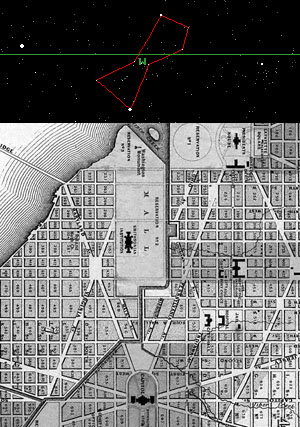
It has already been established that the Goddess can be symbolized by an owl.
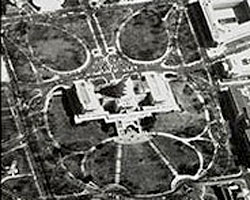
Columbia and the Constellation of Virgo
The District of Columbia has more astrological symbols than and other city in the world. The capitol city was built from the ground up with a specific esoteric design.
There were many changes however, and some things didn't go exactly to plan.
In David Ovason’s book, The Secret Architecture of our Nation’s Capital ... The District of Columbia and its Federal City were arranged, according to Ovason, so that the constellation of Virgo and its goddess symbolism dominates the structure.
Ovason notes that the right triangle of first magnitude stars that contains the constellation Virgo, Arcturus, Regulus and Spica, can also be found in the plan of the Federal city marked by the location of the Capital, the President’s House and the Washington Monument.
And he also notes that the consecration ceremonies for these sites all include prominent astrological connections to Virgo...
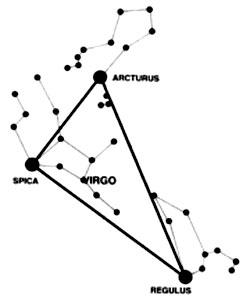
This earth/sky alignment can be seen every year, weather permitting, around August 10th, as the sun sets down the Pennsylvania avenue sight line from the Capital, the great triangle enclosing Virgo appears in the darkening sky.
It was not as obvious 200 years ago when the plan was laid out, but now, at the moment of culmination, the alignment is clear and unmistakable.
As Ovason insists, it is plain that from its inception, the District of Columbia, and the Federal City,
“was intended to celebrate the mysteries of Virgo - of the Egyptian Isis, the Grecian Ceres and the Christian Virgin."
Source
http://www.bibliotecapleyades.net/sociopolitica/esp_sociopol_washingtonDC09.htm
|
|
|
|
|
| |
New International Version (©1984)
He is the Maker of the Bear and Orion, the Pleiades and the constellations of the south.
New Living Translation (©2007)
He made all the stars--the Bear and Orion, the Pleiades and the constellations of the southern sky.
English Standard Version (©2001)
who made the Bear and Orion, the Pleiades and the chambers of the south;
New American Standard Bible (©1995)
Who makes the Bear, Orion and the Pleiades, And the chambers of the south;
King James Bible (Cambridge Ed.)
Which maketh Arcturus, Orion, and Pleiades, and the chambers of the south.
GOD'S WORD® Translation (©1995)
He made [the constellations] Ursa Major, Orion, and the Pleiades, and the clusters of stars in the south.
King James 2000 Bible (©2003)
Who makes the Bear, Orion, and Pleiades, and the chambers of the south.
American King James Version
Which makes Arcturus, Orion, and Pleiades, and the chambers of the south.
American Standard Version
That maketh the Bear, Orion, and the Pleiades, And the chambers of the south;
Douay-Rheims Bible
Who maketh Arcturus, and Orion, and Hyades, and the inner parts of the south.
Darby Bible Translation
Who maketh the Bear, Orion, and the Pleiades, and the chambers of the south;
English Revised Version
Which maketh the Bear, Orion, and the Pleiades, and the chambers of the south.
Webster's Bible Translation
Who maketh Arcturus, Orion, and Pleiades, and the chambers of the south.
World English Bible
He makes the Bear, Orion, and the Pleiades, and the rooms of the south.
Young's Literal Translation
Making Osh, Kesil, and Kimah, And the inner chambers of the south.
|
|
|
|
|
|
|
-
Haz hecho público que te gusta. Deshacer
-
Haz hecho público que te gusta. Deshacer
-
Haz hecho público que te gusta. Deshacer
-
Haz hecho público que te gusta. Deshacer
-
Haz hecho público que te gusta. Deshacer
-
Haz hecho público que te gusta. Deshacer
-
Haz hecho público que te gusta. Deshacer
-
Haz hecho público que te gusta. Deshacer
-
Haz hecho público que te gusta. Deshacer
-
Haz hecho público que te gusta. Deshacer
|
|
|
|
|
Sacred land or high land, the name of a country on one of the mountains of which the ark rested after the Flood subsided ( Genesis 8:4). The "mountains" mentioned were probably the Kurdish range of South Armenia. In 2 Kings 19:37, Isaiah 37:38, the word is rendered "Armenia" in the Authorized Version, but in the Revised Version, "Land of Ararat." In Jeremiah 51:27, the name denotes the central or southern portion of Armenia. It is, however, generally applied to a high and almost inaccessible mountain which rises majestically from the plain of the Araxes. It has two conical peaks, about 7 miles apart, the one 14,300 feet and the other 10,300 feet above the level of the plain. Three thousand feet of the summit of the higher of these peaks is covered with perpetual snow. It is called Kuh-i-nuh, i.e., "Noah's mountain", by the Persians. This part of Armenia was inhabited by a people who spoke a language unlike any other now known, though it may have been related to the modern Georgian. About B.C. 900 they borrowed the cuneiform characters of Nineveh, and from this time we have inscriptions of a line of kings who at times contended with Assyria. At the close of the seventh century B.C. the kingdom of Ararat came to an end, and the country was occupied by a people who are ancestors of the Armenians of the present day.
|
|
|
|
|
| Fixed star: ARCTURUS |
| Constellation: Alpha (α) Bootes |
| Longitude 1900: 22LIB50 |
Longitude 2000: 24LIB14 |
| Declination 1900: +19.42' |
Declination 2000: +19.11' |
| Right ascension: 14h 15m |
Latitude: +30.44' |
| Spectral class: K2 |
Magnitude: -0.04 |
The history of the star: Arcturus
from p.98 of Star Names, Richard Hinckley Allen, 1889.
[A scanned copy can be viewed on this webpage]
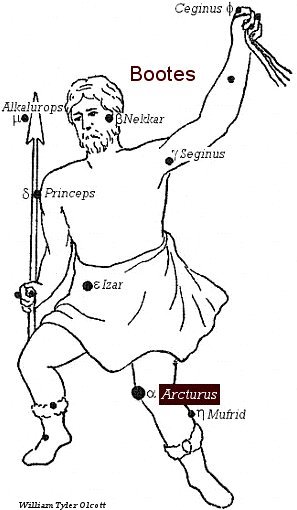 Alpha (α) Bootes, Arcturus, is a golden red star situated on the left knee of the Herdsman, the 4th brightest in the sky. Alpha (α) Bootes, Arcturus, is a golden red star situated on the left knee of the Herdsman, the 4th brightest in the sky.
Arcturus has been an object of the highest interest and admiration to all observant mankind from the earliest times, and doubtless was one of the first stars to be named; for from Hesiod's day to the present it thus appears throughout all literature, although often confounded with the Greater Bear (Ursa Major). Indeed Hesiod's use of the word probably was for that constellation (Bootes), except in two cases, already quoted, where he unquestionably referred to this star, mentioning its rising fifty days after the winter solstice, the first allusion that we have to that celestial point. And it is popularly supposed that {p.99} our Arcturus is that of the Book of Job, xxxviii, 32; but there it merely is one of the early titles of Ursa Major, the Revised Version correctly rendering it "the Bear." Still, even now, the Standard Dictionary quotes for the star the Authorized Version's
"Canst thou guide Arcturus with his sons ?"
But, like other prominent stars, it shared its name with its constellation — in fact, probably at first, and as late as Pliny's day (23-79 A.D.), was a constellation by itself. Homer's Bootes doubtless was this, with, possibly, a few of its larger companions; and the 17th century German astronomer Bayer cited Bootes for the star; but in recent times the latter has monopolized the present title.
It was famous with the seamen of early days, even from the traditional period of the Arcadian Evander, and regulated their annual festival by its movements in relation to the sun. But its influence always was dreaded, as is seen in the Greek astronomer Aratus', circa 270 B.C., deinou Arktouroio and Pliny's (23-79 A.D.) horridum sidus; while Demosthenes, in his action against Lacritus 341 B.C., tells us of a bottomry bond, made in Athens on a vessel going to the river Borysthenes — the modern Dnieper—and to the Tauric Chersonese—the Crimea—and back, that stipulated for a rate of 22 ½ per cent, interest if she arrived within the Bosporus "before Arcturus," i.e. before its heliacal rising about mid-September; after which it was to be 30 per cent. Its acronycal rising fixed the date of the husbandmen's Lustratio frugum; and Vergil (70-19 B.C.) twice made allusion in his 1st Georgic to its character as unfavorably affecting the farmers' work. Other contemporaneous authors confirmed this stormy reputation, while all classical calendars gave the dates of its risings and settings.
Hippocrates, 460 B.C., made much of the influence of Arcturus on the human body, in one instance claiming that a dry season, after its rising,
"agrees best with those who are naturally phlegmatic, with those who are of a humid temperament, and with women; but it is most inimical to the bilious;"
and that
"diseases are especially apt to prove critical in these days."
{p.100} The Prologue of the Rudens of Plautus, delivered by Arcturus in person, and "one of the early opinions of the presence of invisible agents amongst mankind," declares of himself that he is considered a stormy sign at the times of his rising and setting,— as the original has it:
"Arcturus signum, sum omnium quam acerrimum. Vehemens sum, cum exorior, cum occido vehementior."
And the passage from Horace's (65-8 B.C.) Odes —
"Nec saevus Arcturi cadentis Impetus aut orientis Haedi —"
is familiar to all. This same idea came down to modern days, for Pope repeated it in his verse,
"When moist Arcturus clouds the sky."
Astrologically, however, the star brought riches and honor to those born under it.
An Egyptian astronomical calendar of the 15th century before Christ, deciphered by Renouf, associates it with the star Antares in the immense sky figure Menat; and Lockyer claims it as one of the objects of worship in Nile temples, as it was in the temple of Venus at Ancona in Italy.
In India it was the 13th nakshatra (Hindu Moon Mansion), Svati, the Good Goer, or perhaps Sword, but figured as a Coral Bead, Gem, or Pearl; and known there also as Nishtya, Outcast, possibly from its remote northern situation far outside of the zodiac, whence, from its brilliancy, it was arbitrarily taken to complete the series of Hindu asterisms. Hewitt thinks that it, or Capella, was the Aryaman of the Rig Veda; and Edkins that it was the Tistar usually assigned to Sirius.
The Chinese called it Ta Kio, the Great Horn, four small stars near by being Kang Che, the Drought Lake; Edkins further writing of it:
"Arcturus is the palace of the emperor. The two groups of three small stars on its right [eta, iota (ι), and upsilon (υ)] are called She ti, the Leaders, because they assign a fixed direction to the tail of the Bear, which, as it revolves, points out the twelve hours of the horizon."
The Arabs knew Arcturus as Al Simak1 al Ramih (Allen notes: This word Simak is from a root meaning "to raise on high," and is thought to have been employed by the Arabs when they wished to indicate any prominent object high up in the heavens, but with special reference to this star and to the other Simak, Spica of the Virgin.), sometimes translated the Leg of the Lance-bearer, and again, perhaps more correctly, the Lofty {p.101} Lance-bearer. From the Arabic title came various degenerate forms: Al Ramec, Aramec, Aremeah, Ascimec, Azimech, and Azimeth, found in thou queer compendiums of stellar nomenclature the Alfonsine Tables and the Almagest of 1515; Somech haramach of English writer on globes John Chilmead (circa 1639)'s Treatise; and Aramakh, which Karsten Niebuhr heard from the Arabs 136 years ago. The Kheturus of their predecessors, already alluded to under Bootes, also was used for this.
The idea of a weapon again manifested itself in the Kontaratos, Javelin-bearer, of the Graeco-Persian Tables; while the 17th century German astronomer Bayer had Gladius, Kolanza, and Pugio, all applied to Arcturus, which probably marked in some early drawing the Sword, Lance, or Dagger in the Hunter's hand. Similarly it took the title Alkameluz of the whole constellation.
Al Haris al Sama, the Keeper of Heaven, perhaps came from the star's early visibility in the twilight owing to its great northern declination, as though on the lookout for the safety and proper deportment of his lesser stellar companions, and so "Patriarch Mentor of the Train." This subsequently became Al Haris al Simak, the Keeper of Simak, probably referring to Spica, the Unarmed One.
The Persian astronomer Al Biruni (973-1048 A.D.) mentioned Arcturus as the Second Calf of the Lion, the early Asad [Arabs had an enormous Lion, their early Asad, extending over a third of the heavens, of which the stars Arcturus and Spica were the shin-bones; Regulus, the forehead; the heads of Gemini, one of the fore paws; Canis Minor, the other; and Corvus, the hind quarters. Many Arab starnames come from this tradition. Star Names p.97.]; Spica being the First Calf.
It has been identified with the Chaldaeans' Papsukal, the Guardian Messenger, the divinity of their 10th month Tibitu; while Smith and Sayce have said that on the Euphrates it was the Shepherd of the Heavenly Flock, or the Shepherd of the Life of Heaven, undoubtedly the Sib-zi-anna of the inscriptions; the star eta (η) (Mufrid) being often included in this, and thus making one of the several pairs of Euphratean Twin Stars.
The 1515 Almagest and the Alfonsine Tables of 1521 add to their list of strange titles et nominatur Audiens, which seems unintelligible unless the word be a misprint for Audens, the Bold One.
John de Wiclif, in his translation of Amos v, 8, in 1383, had it Arture, which he took from the Vulgate's Arcturus for Ursa Major; but John of Trevisa in 1398 more correctly wrote:
"Arthurus is a signe made of VII starres, . . . but properly Arthurus is a sterre sette be-hynde the tayle of the synge that hyght Vrsa maior (Ursa Major)."
With others it was Arturis and Ariture, or the Carlwaynesterre from the early confusion in applying the title Arcturus to Charles' Wain as well as to Bootes and its lucida (brightest star in the constellation).
Prominent as this star always has been, and one of the few to which the second-century Greek astronomer Ptolemy assigned a name, yet its position has greatly varied in the drawings; {p.102} indeed in the earliest it was located outside of the figure and so described in the Syntaxis. It has been put on the breast; in the girdle, whence, perhaps, came the 17th century German astronomer Bayer's Arctuzona; on the leg; between the knees, — Robert Recorde, the first English writer on astronomy, in 1556 mentioning in the Castle of Knowledge the "very bryghte starre called Arcturus, which standeth between Bootes his legges"; and, as some of its titles denote, on the weapon in the hand. But since Durer's time it has usually marked the fringe of the tunic.
[Star Names, Their Lore and Meaning, Richard Hinckley Allen, 1889].
According to E W Bullinger (The Witness of the Stars ), a biblical interpreter of the constellations, the ancient Egyptians called Bootes Smat, which means one who rules, subdues, and governs. They also called him Bau, which means also "the coming one". [Robson*]
The star Arcturus by Isidore of Seville:
Arctophylax (i.e. the 'bear-keeper') is so named because it follows Arctos, that is, the Great Bear (Ursa Major). People have also called this constellation Bootes, because it is attached to the Wain (Ursa Major). It is a very noticeable sign with its many stars, one of which is Arcturus. Arcturus is a star located in the sign of Bootes beyond the tail of the Great Bear. For this reason it is called Arcturus, as if it were the Greek arktos oura (i.e. 'tail of the bear'), because it is located next to the heart of Bootes. It rises in the season of autumn.” [The Etymologies of Isidore of Seville, 7th century AD, p.105.]
The Lunar Mansions
In India Arcturus was the 13th nakshatra (Hindu Moon Mansion), Svati, the Good Goer, or perhaps Sword, but figured as a Coral Bead, Gem, or Pearl; and known there also as Nishtya, Outcast, possibly from its remote northern situation far outside of the zodiac, whence, from its brilliancy, it was arbitrarily taken to complete the series of Hindu asterisms (Allen Star Names, p.98.). Robson says the regent, Vayu, the god of the wind. Ruled by the Dragon's Head.
Influences of the 13th Hindu Moon Mansion Svati: A mutable asterism belonging to the butcher caste and favorable for commencing work of an impermanent or moving character. Those born on the lunar day will be weak, abstemious, skilful, fond of animals and changeable in friendship. With Moon here at birth native will be quiet, polite, self-controlled, skilful, kind-hearted and charitable. Rules rice fields and the breast. [Robson*, p.81.]
The astrological influences of the constellation Bootes
Bootes is identified with Icarius, who was killed by some shepherds he had made drunk with a flagon of wine given him by Bacchus/Dionysus. In consideration of the grief of his daughter Erigone and their hound Maera, Jupiter placed her father in heaven as Bootes, together with herself as Virgo and the hound became one of the Dogs; some say Canis Minor, others say Canis Major.
According to Ptolemy the influence of the constellation is like that of Mercury and Saturn, though the star Arcturus is like Mars and Jupiter. It is said to give prosperity from work, strong desires, a tendency to excess, a fondness for rural pursuits, together with some liking for occultism. The Kabalists associate it with the Hebrew letter Teth and the 9th Tarot Trump, "The Hermit". [Robson*, p.32.]
The astrological influences of the constellation Bootes given by Manilius:
"True is the name men have given him (the Bearwarden), threatening-like he presses forward as one does over a team of bullocks. To those born under Arctophylax - Arcturus, fortune herself makes bold to entrust her treasures, so that the wealth of monarchs and temple finances will be in their keeping [translator's note: custodianship is a suitable endowment for the Bearward]; they will be kings under kings and ministers of state, and be charged with the guardianship of the people or, as the stewards of grand houses, they will confine their business to the care of another's home." [Translator's note: strictly speaking Arcturus is a star, but the name is used by ancient astrologers for the whole constellation of Bootes and for the star alone, it is often difficult to distinguish which of these the authors are referring to]. [Manilius, Astronomica, 1st century AD, book 5, p.329.]
The astrological influences of the star Arcturus
According to Ptolemy it is of the nature of Mars and Jupiter, but Alvidas substitutes Venus and Mercury conjoined. It gives riches, honors, high renown, self-determination and prosperity by navigation and voyages. [Robson*, p.139.]
"Bear leader-guardian", meaning observer of the "Great Bear", or "The Saucepan" or "Big Dipper" respectively. Main star of constellation Bootes (= driver of oxen), has a Jupiter-Mars nature, and a reputation of achieving "justice through power". It therefore makes the native belligerent and quarrelsome, especially if attached to Mars and Jupiter by conjunction. A really go-ahead and enterprising spirit is here the rule, as indicated by Jupiter-Mars. Lasting success is promised if further good aspects are present. If critically aspected, the good influence will be hampered or made into a real handicap. If involved in legal action, such a native may lose all. [Fixed Stars and Their Interpretation, Elsbeth Ebertin, 1928, p.63.]
If rising: Good fortune, with many cares and anxieties through own folly. [Robson*, p.139.]
If culminating: High office under Government, great profit and reputation. If at the same time with Sun, Moon or Jupiter, ample fortune and great honor. [Robson*, p.139.]
With Sun: Success through slow and patient plodding, friends among clergy, favorable for gain and for dealing with the public and lawyers. [Robson*, p.139.]
With Moon: New friends, business success, good judgment, domestic harmony. If with Mars also, danger of death by suffocation. [Robson*, p.139.]
With Mercury: Sober, industrious, popular, inclined to be religious, somewhat extravagant but well-off, help through friends, holds position of trust in large company or corporation, or receives promotion under direction, favorable for health and domestic affairs. [Robson*, p.139.]
With Venus: Popular, gifts and favors from friends, some false friends of own sex. [Robson*, p.140.]
With Mars: Popular, many friends, considerable gain but does not save owing to extravagance. If in 1st, 7th, 9th, 10th or 11th houses and the Moon is at the same time with Pollux, danger of death by suffocation. [Robson*, p.140.]
With Jupiter: Benefits from legal and Church matters, influential position, danger of hypocrisy gain through foreign affairs or shipping. [Robson*, p.140.]
With Saturn: Honest, selfish, inclined to be mean, shrewd in business, materialistic, favorable for gain and speculation and for domestic matters, but early difficulty in married life, favorable for children but disagreement with one of them. [Robson*, p.140.]
With Uranus: Favorable for work entailing quick buying and selling and for dealing with the public, associated with antiques or ancient matters and given to forming collections, associated with art science or literature, official position in some club or society, favorable for gain, benefits from friends, favorable for marriage and children and benefit through both, natural death abroad. [Robson*]
With Neptune: Ingenious, business instincts, changeable, and loss through this means, mediumistic and rather negative, associated with societies as an official, loss and misfortune in middle age which hastens death, favorable for friendship, partnership, marriage and success, greatly dependent upon advice of marriage partner. [Robson*, p.140.]
http://www.constellationsofwords.com/stars/Arcturus.html
|
|
|
|
|
|
by ViolatoR
February 19, 2007
from AboveTopSecret Website
The Origin of Columbia
Today I would like to discuss the Goddess and how it is associated with the capitol of America - the District of Columbia. There will be plenty of background information, but I will try to maintain emphasis on the most recent aspect of the goddess as Columbia.
To begin...
Wikipedia: "Though he never set foot in what became the United States, Columbus is often viewed as a hero because of his pivotal role in U.S. history."
Columbus was fortunate enough to have a very symbolic name.
It would later be used to a great extent in America for it's many meanings and aspects, and slight historical significance. In fact Columbia would become the name of a new Goddess for a New World (NWO?).
Almost from the moment the New World was discovered, it was seen in mythological terms as an exotic goddess, an Indian Queen dressed in feathers and furs ridding an exotic beast like an armadillo and armed with a tomahawk.
The Catholic south adapted the idea of the Goddess of the New World into the ever-expanding hagiology of the Catholic Church.
The Virgin of Guadalupe allowed the archetype to become personal, a connection to the land and its ancestors, while joining a larger universalist vision inside the Church. In the largely Protestant north, things went quite differently.
The 17th century’s Indian Goddess became a tamer Indian Princess, modeled on the archetypal story of Pocahontas...
As the 18th century passed, and America grew more developed and its people more educated, the Indian princess gained a touch of Greek elegance.
"By the late 1790s," folk-art historian Nancy Jo Fox comments, "it was not clear whether a feathered Indian Princess had changed into a Greek goddess or whether a Greek goddess had placed feathers or plumes in her hair."
Source
Her Many Other Names
Most Female/Virgin/Goddess symbolism comes from the constellation Virgo.
The Virgin, Virgo was impregnated by God on the Spring Equinox as the Sun passed into Virgo on March 21st. Nine months later the Son of God is born on the Winter Solstice.
God's sun/son is born or rather re-born every year after the Sun stops on the Tropic of Capricorn for 2 days and on the third day rises from death and is re-incarnated into the world. It then proceeds to come back towards the Northern Hemisphere as the "light of the world."
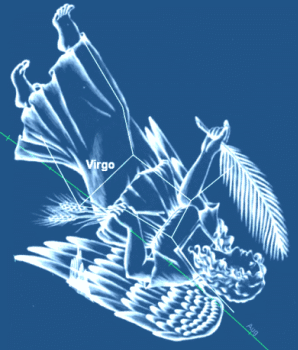
The New World Virgin Goddess Columbia was just a new manifestation of the ancient consort and virgin mother of god.
Depicted in Christianity as the Virgin Mary, Columbia was created out of Virginia and Maryland. To the Masons, the Square is the female aspect.
Washington's original plan for D.C. was a large square with the future Washington Monument (male symbol, compass) at the center.
In Egypt the trinity consists of Isis, Osiris, and Horus the son. Isis can be seen as the ultimate female deity.
Isis may be the oldest deity in Egypt, and certainly the oldest to survive the ages in much the same form. She may also be the most important, for although the other gods were worshipped widely, Isis was worshipped almost universally by all Egyptians. The major goddess of the Egyptian pantheon, she had many of the same attributes of other mother-goddesses found all over the world.
Source
Isis was as powerful, if not more powerful, than Osiris and Ra.
Isis was also known as Sopdet, consort of Sah. Sopdet (Spdt, Sepedet) is Sothis in greek. In 'The Lamentations of Isis and Nephthys for Osiris', Isis calls herself Sopdet. Sopdet was also connected to the goddess Satet at Abu (Elephantine).
Besides these names, the same aspects of any Goddess can be found in:
-
Aphrodite, Ishtar, Black Madonna, Mary/Maya, Goddess Athena, Goddess Astarte, Anunit, Astarte and Atarsamain
-
She was the light-giver at this season of the year and was called Khut
-
As the mighty earth-goddess her name was Usert
-
As the Great Goddess of the Underworld she was Thenenet
-
As the power which shot forth the Nile flood, she was Sati, and Sept
-
As the embracer of the land and producer of fertility by her waters she was Anqet
-
As the producer and giver of life she was Ankhet
-
As the goddess of cultivated lands and fields she was Sekhet
-
As the goddess of the harvest she was Renenet
-
As the goddess of food which was offered to the gods, she was Tcheft, and lived in the Temple of Tchefau
-
As the great lady of the Underworld, who assisted in transforming the bodies of the blessed dead into those wherein they were to live in the realm of Osiris, she was Ament - the "hidden" goddess. As Ament she was declared to be the mother of Ra
-
To the Greeks she was known as Demeter and to the Romans as Ceres
-
To the Chinese protestors of Red Square as the goddess of Democracy
 
-
And of course the Goddess of the New World - Lady Liberty - Columbia
Attributes of the Goddess
The Goddess can be represented in many different ways.
As Venus she is depicted as, or on a clam shell. She is often depicted as a 5 pointed star, or wearing a pentacle as a crown. There's the Triple Goddess of the 3 phases of the moon. The flag of the District of Columbia has 3 five-pointed stars on it.
As the star Sirius she is the Blazing Star and represents water and the color blue, the Spirit of Wisdom and the Brightly Radiating One or Shinning One.
The sycamore specifically was regarded as a manifestation of the goddesses Nut, Isis and Hathor, who was even given the title, "Lady of the Sycamore." Also as the virgin Columbian Flower with it's 5-Petals.
As Innana, Isis, Athena and Minerva she is often depicted with an Owl.
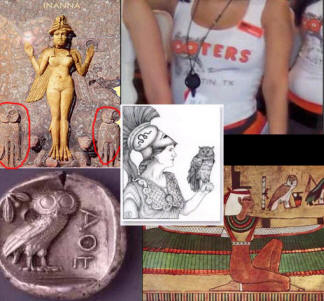
But perhaps the most attributes come when in the form of Columbia.
She is most often shown with an eagle, broken chains and pottery, a cornucopia, images of George Washington, a laurel wreath, a liberty pole and cap, a liberty tree, an olive branch, a rattlesnake, a shield and a stone tablet.
The statue of Columbia that used to stand behind the speaker's chair in the House of Representatives is a fine example. In this one we see the Eagle, and on the other side a snake coiled around a Greek column.
Source

 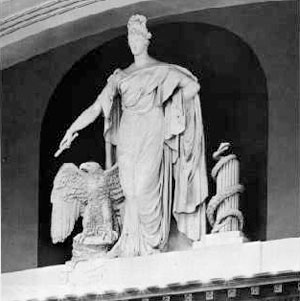
Mother Earth, Primeval Waters, Constellations and Aliens?
Gen.1
[1] In the beginning God created the heaven and the earth.
[2] And the earth was without form, and void; and darkness was upon the face of the deep. And the spirit of God moved upon the face of the waters.
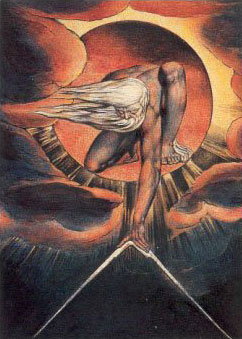
Early in Egyptian history, Isis had absorbed the attributes of all the great primitive goddesses, and of all the local goddesses such as
-
Nekhebet
-
Uatchet
-
Net
-
Bast, Hathor, etc.,
...and she was even identified as the female counterpart of the primeval abyss of water from which sprang all life.
Virgin Mary
The name Mary could have some significance to it's connection with the sea, the Abyss, or the water of life which brings fertility to the land in the form of rain or annual floods.
Usual English form of Maria, which was the Latin form of the New Testament Greek names Μαριαμ (Mariam) or Μαρια (Maria) (the spellings are interchangeable), which were from the Hebrew name מִרְיָם (Miryam). The meaning is not known for certain, but there are several theories including "sea of bitterness."
marine (adj.) Look up marine at Dictionary.com
c.1420, from M.Fr. marin (fem. marine), from O.Fr. marin, from L. marinus (fem. marina) "of the sea," from mare (gen. maris) "sea," from PIE *mori-/*mari- "body of water, lake." Cognate with O.E. mere "sea, lake, pool, pond,"
|
|
|
|
|
Isis = Sirius, Osiris = Orion
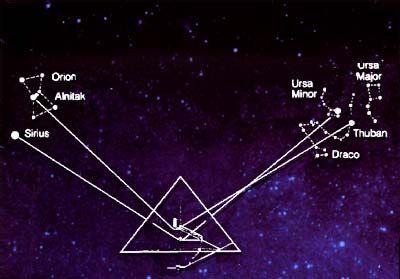
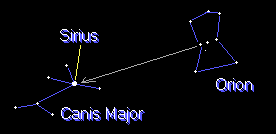
(The goddess star Sirius) In the ancient Vedas this star was known as the Chieftain's star; in other Hindu writings, it is referred to as Sukra, the Rain God, or Rain Star. The Dog is also described as "he who awakens the gods of the air, and summons them to their office of bringing the rain."
Source
This star was the most important of the stars to the ancient Egyptians, and the heliacal rising of this star came at the time of inundation and the start of the Egyptian New Year.
She marked the Summer solstice
As a goddess of the inundation, Sothis was a goddess of fertility.
She also was linked to the pharaoh and his journey in the afterlife. It is interesting to note that Sirius is associated with the flood season. Located just below the Dog Star there exists a constellation called Argo, the Ship.
Near the Cannis Major constellation is the Columb or Dove constellation, depicted with a twig in it's mouth.
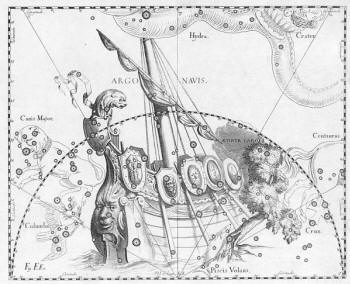
Canis Major and Columba can be seen on the left
The Dogon and Sirius
The Dogon are an ethnic group located mainly in the administrative districts of Bandiagara and Douentza in Mali, West Africa. Dogon religion is defined primarily through the worship of the ancestors and the spirits... They were called the 'Nommo.'
The Dogon are famous for their astronomical knowledge taught through oral tradition... referencing the star system, Sirius.
As the story goes... in the late 1930s, four Dogon priests shared their most important secret tradition with two French anthropologists, Marcel Griaule and Germain Dieterlen after they had spent an apprenticeship of fifteen years living with the tribe. These were secret myths about the star Sirius, which is 8.6 light years from the Earth.
The Dogon priests said that Sirius had a companion star that was invisible to the human eye.
They also stated that the star moved in a 50-year elliptical orbit around Sirius, that it was small and incredibly heavy, and that it rotated on its axis. The Dogons calendar is quite non-traditional in that its fifty year cycle is based neither on the Earth's rotation around the Sun (as is our Julian calendar) nor the cycles of the Moon (a lunar calendar).
Instead, the Dogon culture centers around the rotation cycle Sirius B which encircles the primary star Sirius A every 49.9 - or 50 years...
Since 1844, astronomers had suspected that Sirius A had a companion star. This was in part determined when it was observed that the path of the star wobbled. In 1862 Alvan Clark discovered the second star making Sirius a binary star system (two stars).
The Dogon also claimed that a third star Emme Ya - sorghum female - exists in the Sirius system.
It is described by the Dogan as,
"the seat of the female souls of living or future beings."
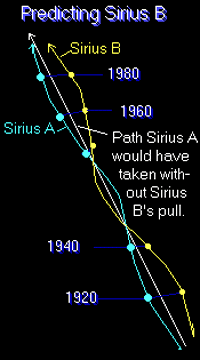
The Nommo
Author Robert Temple describes the Nommo as amphibious beings sent to Earth from the Sirius star system for the benefit of humankind.
They look like Merfolk; Mermaids and Mermen. They called the Nommo 'Masters of the Water', 'The Monitors', 'The Teachers or Instructors', 'Saviors', and 'Spiritual Guardians'.
The Dogon elder, Ogotemelli, describes Nommo as having the upper part as a man and the lower portion as snake; or as having a ram's head with serpent body.
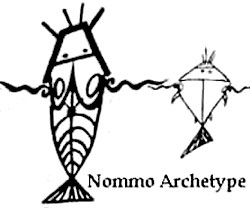
As The Dog Star
As the major star of the "Big Dog" constellation, Sirius is often called the "Dog Star."
The name "Sirius" comes from the Latin Si-rius, from Greek Seirios, "glowing" or "scorcher." The Arabic word Al Shi'ra resembles the Greek, Roman, and Egyptian names suggesting a common origin in Sanskrit, in which the name Surya, the Sun God, simply means the "shining one."
It was thought that Sirius actually added to earth's heat because it was so bright.
This has been used to describe the origin of the phrase "dog days of summer."
Sirius was an object of wonder and veneration to all ancient peoples throughout human history.
The association of Sirius with a celestial dog has been consistent throughout the classical world; even in remote China, the star was identified as a heavenly wolf. In ancient Chaldea (present day Iraq) the star was known as the "Dog Star that Leads," or it was called the "Star of the Dog."
In Assyria, it was said to be the "Dog of the Sun." In still older Akkadia, it was named the "Dog Star of the Sun."
In Greek times Aratus referred to Canis Major as the guard-dog of Orion, following on the heels of its master, and standing on its hind legs with Sirius carried in its jaws. Manilius called it the "dog with the blazing face."
Source
She was occasionally depicted as a large dog, or in Roman times, as the goddess Isis-Sopdet, she was shown riding side-saddle on a large dog. Sometimes she was depicted as a seated cow.
She was also given a masculine aspect, and linked with Horus as Sopdet-Horus during the Middle Kingdom. She was also linked with Anubis during Greek Times as Sopdet-Anubis. (Anubis has the head of a dog or jackal.)
Sirius and Orion Over Washington
The Congress of Isis and Osiris just so happens to happen above... Congress.
Washington D.C. and many of it's buildings and monuments are laid out according to the cardinal directions with the streets running due NS and EW.
In the map of Washington D.C. below, due east is up and the star chart shows the constellation of Orion rising due east over Washington D.C., as it has done every day for the past two hundred years.
Orion's belt points towards Sirius, the brightest star in the sky, and while Orion is rising and low on the eastern horizon, Orion's belt is vertical, pointing to Sirius below.

|
|
|
|
|
In relation to the fixed stars, the sun rises later each day due to the rotation of the earth around the sun.
The sun rises just after Sirius at the latitude of Washington D.C. on August 15. This is known as the heliacal rising of Sirius. Prior to this time of year, the sun is above or too close to the horizon for the rising of the star to be visible.
Ancient Egyptians based their calendar on the heliacal rising of Sirius, which signaled the onset of the annual flooding of the Nile. Christians celebrate the Assumption of the Virgin Mary on August 15, linking the Assumption to the first appearance of Sirius/Isis in the sky just before dawn.
Orion has also set due west at the latitude of Washington D.C. for the past two hundred years.
From the viewpoint of the Capitol building, Orion sets right behind the Washington Monument. Setting in the west, Orion's belt is horizontal, pointing to Sirius setting south of due west.
From the viewpoint of the Capitol building, Sirius sets over the Potomac River, on the alignment of Maryland Avenue. The bright star above Orion is Aldebaran, the alpha star in the constellation of Taurus.
From the viewpoint of the Capitol building, Aldebaran sets over the White House, on the alignment of Pennsylvania Avenue.
Source

It has already been established that the Goddess can be symbolized by an owl.

Columbia and the Constellation of Virgo
The District of Columbia has more astrological symbols than and other city in the world. The capitol city was built from the ground up with a specific esoteric design.
There were many changes however, and some things didn't go exactly to plan.
In David Ovason’s book, The Secret Architecture of our Nation’s Capital ... The District of Columbia and its Federal City were arranged, according to Ovason, so that the constellation of Virgo and its goddess symbolism dominates the structure.
Ovason notes that the right triangle of first magnitude stars that contains the constellation Virgo, Arcturus, Regulus and Spica, can also be found in the plan of the Federal city marked by the location of the Capital, the President’s House and the Washington Monument.
And he also notes that the consecration ceremonies for these sites all include prominent astrological connections to Virgo...

This earth/sky alignment can be seen every year, weather permitting, around August 10th, as the sun sets down the Pennsylvania avenue sight line from the Capital, the great triangle enclosing Virgo appears in the darkening sky.
It was not as obvious 200 years ago when the plan was laid out, but now, at the moment of culmination, the alignment is clear and unmistakable.
As Ovason insists, it is plain that from its inception, the District of Columbia, and the Federal City,
“was intended to celebrate the mysteries of Virgo - of the Egyptian Isis, the Grecian Ceres and the Christian Virgin."
Source
Pierre-Charles L’Enfant and the Design of Washington
Pierre-Charles L’Enfant... adventurous Frenchman and a contemporary of Weishaupt, who was primarily responsible for the name and design of the District of Columbia...
Pierre was educated first as an artist, where he studied the science of landscape design from the works of Andre le Notre, who designed the great historical axis of Paris, and then as a soldier, where he learned the art of fortification.
In 1776, as a lieutenant, he joined his regimental Masonic lodge where he met the Marquis de Lafayette and many other young Frenchmen fired up by the new ideals of liberty and equality. In 1777, he offered his services to the new Continental Army of General Washington, and was appointed a captain of engineers...
When he learned, in 1789, that his old friend General Washington was planning to establish a new federal capital down in Virginia, L’Enfant wrote directly to him, announcing that,
“…no nation, perhaps, had ever before the opportunity offered them of deliberately deciding on the spot where their capital city should be fixed.”
Arriving in Georgetown early in 1791, armed with Washington’s instructions to assist the current surveyors... L’Enfant quickly took charge...
Andrew Ellicott, the chief surveyor was a knowledgeable astronomer, and he undoubtedly helped fix the precise point on the horizon marking the August11th sunset.
This angle, 22 degrees north of west, did double duty, pointing to the sunset where, 200 years later, the triangle containing Virgo would appear in the sky and also marking the September 18th rising of Sirius over the Capital. This one alignment, from the Capital to the White House, graphically unites the two most prominent astronomical goddess images, Sirius and Virgo.
L’Enfant’s plan was changed through the years, and his steadfast defense of certain points led to his being considered difficult. He wanted to keep intact not only the precise sightlines of his alignments... L’Enfant’s idea was to preserve a direct view of the western horizon for the mid-August time period when the Virgo triangle appeared in the sky... the earthly reflection of the Virgo triangle.
While this view has been destroyed, the careful angle of Pennsylvania Avenue from the Capital to the White House still allows us to identify the crucial moment of revelation.
Source
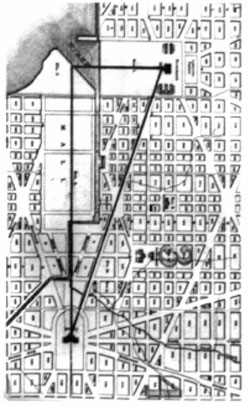
The Goddess of... Revelations?
Revelation 12:
[1] And there appeared a great wonder in heaven; a woman clothed with the sun, and the moon under her feet, and upon her head a crown of twelve stars.
[2] And she being with child cried, travailing in birth, and pained to be delivered.
[3] And there appeared another wonder in heaven; and behold a great red dragon, having seven heads and ten horns, and seven crowns upon his heads.
[4] And his tail drew the third part of the stars of heaven, and did cast them to the earth: and the dragon stood before the woman which was ready to be delivered, for to devour her child as soon as it was born.
[5] And she brought forth a man child, who was to rule all nations with a rod of iron: and her child was caught up unto God, and to his throne.
The moment the sages of 1177 foresaw, just after the turn of the seventh millennium of the Hebrew calendar and the beginning of the third Christian millennium, the alignment of eclipse cycle and the sacred calendars, occurred on October 3/4th, 2005, and two days later, on October 5/6th, the great portent appeared in the sky.
The sun in Virgo, from a sidereal perspective, falling on the Virgin’s robed shoulder, “clothed by the Sun,” a thin crescent moon on the cusp of Virgo/Libra, “with the Moon under her feet,” and “pregnant” with the conjunction of Mercury, Jupiter and the alpha star of Virgo, Spica, at the level of her womb.
“Crowned with twelve stars,” suggests the return of the cusp of Virgo/Leo, ancient starting point of the zodiac, to the fall equinox.
The Red Dragon, even with all its evil connotations, can be seen as the Head of the Dragon marking the solar eclipse, waiting to eat the child, the Sun/Son, the moment it is born.
So, in Washington City, at noon on October 5/6th, 2005, even though the sun was veiling the event, the Great Portent moved into alignment over the city’s monuments. The White House’s south front would have been a good place to view it, and in our computer view, that’s our observation point.
As the Sun touched the meridian on October 5th, the whole of the Portent spread out to the east, from meridian to eastern horizon.
The first thing we notice is that the Washington Monument is not due south of the White House, as L’Enfant planned. It is offset to the east just enough to align with the fixed star Spica and the conjunction of Jupiter and Mercury. This is apparently not accidental, as the dedication ceremony for its present location, done in 1880, was aligned down the Mall with the rising of Spica...
Further down the Mall to the east is the new Moon, on the Virgo/Libra cusp, under the feet of Virgo, and beyond that in Libra is Venus.
Source
Esoteric and Occult Goddess worship has culminated in the design and purpose of Washington D.C.
Embodied as the Goddess Columbia, who is the new face of an old deity. According to this website (www.goddesscolumbia.com), the design in D.C. was meant to be fulfilled in recent time, and was not exactly aligned until now.
The great 'wonder in heaven' of revelations occurred in October of 2005.
According to the dates set forth in the book of Daniel, Mt. Zion will be in the hands of unbelievers for 2,300 years.
-
The Greeks conquered Israel in 333BC and 2,300 years later in 1967AD the Jews re-conquered it after the 6-Day War.
-
The two other periods linked with the abomination of the Temple are 1,290 and 1,335 years.
-
The Muslims turned the Dome of the Rock into a mosque in 677, and 1,290 years later in 1967 east Jerusalem was annexed by Israel.
-
The other period is 1,335 years after the Muslims captured the Temple.
-
And that is 45 years after 1967, or 2012.
|
|
|
|
|
| Fixed star: ARCTURUS |
| Constellation: Alpha (α) Bootes |
| Longitude 1900: 22LIB50 |
Longitude 2000: 24LIB14 |
| Declination 1900: +19.42' |
Declination 2000: +19.11' |
| Right ascension: 14h 15m |
Latitude: +30.44' |
| Spectral class: K2 |
Magnitude: -0.04 |
The history of the star: Arcturus
from p.98 of Star Names, Richard Hinckley Allen, 1889.
[A scanned copy can be viewed on this webpage]
 Alpha (α) Bootes, Arcturus, is a golden red star situated on the left knee of the Herdsman, the 4th brightest in the sky. Alpha (α) Bootes, Arcturus, is a golden red star situated on the left knee of the Herdsman, the 4th brightest in the sky.
Arcturus has been an object of the highest interest and admiration to all observant mankind from the earliest times, and doubtless was one of the first stars to be named; for from Hesiod's day to the present it thus appears throughout all literature, although often confounded with the Greater Bear (Ursa Major). Indeed Hesiod's use of the word probably was for that constellation (Bootes), except in two cases, already quoted, where he unquestionably referred to this star, mentioning its rising fifty days after the winter solstice, the first allusion that we have to that celestial point. And it is popularly supposed that {p.99} our Arcturus is that of the Book of Job, xxxviii, 32; but there it merely is one of the early titles of Ursa Major, the Revised Version correctly rendering it "the Bear." Still, even now, the Standard Dictionary quotes for the star the Authorized Version's
"Canst thou guide Arcturus with his sons ?"
But, like other prominent stars, it shared its name with its constellation — in fact, probably at first, and as late as Pliny's day (23-79 A.D.), was a constellation by itself. Homer's Bootes doubtless was this, with, possibly, a few of its larger companions; and the 17th century German astronomer Bayer cited Bootes for the star; but in recent times the latter has monopolized the present title.
It was famous with the seamen of early days, even from the traditional period of the Arcadian Evander, and regulated their annual festival by its movements in relation to the sun. But its influence always was dreaded, as is seen in the Greek astronomer Aratus', circa 270 B.C., deinou Arktouroio and Pliny's (23-79 A.D.) horridum sidus; while Demosthenes, in his action against Lacritus 341 B.C., tells us of a bottomry bond, made in Athens on a vessel going to the river Borysthenes — the modern Dnieper—and to the Tauric Chersonese—the Crimea—and back, that stipulated for a rate of 22 ½ per cent, interest if she arrived within the Bosporus "before Arcturus," i.e. before its heliacal rising about mid-September; after which it was to be 30 per cent. Its acronycal rising fixed the date of the husbandmen's Lustratio frugum; and Vergil (70-19 B.C.) twice made allusion in his 1st Georgic to its character as unfavorably affecting the farmers' work. Other contemporaneous authors confirmed this stormy reputation, while all classical calendars gave the dates of its risings and settings.
Hippocrates, 460 B.C., made much of the influence of Arcturus on the human body, in one instance claiming that a dry season, after its rising,
"agrees best with those who are naturally phlegmatic, with those who are of a humid temperament, and with women; but it is most inimical to the bilious;"
and that
"diseases are especially apt to prove critical in these days."
{p.100} The Prologue of the Rudens of Plautus, delivered by Arcturus in person, and "one of the early opinions of the presence of invisible agents amongst mankind," declares of himself that he is considered a stormy sign at the times of his rising and setting,— as the original has it:
"Arcturus signum, sum omnium quam acerrimum. Vehemens sum, cum exorior, cum occido vehementior."
And the passage from Horace's (65-8 B.C.) Odes —
"Nec saevus Arcturi cadentis Impetus aut orientis Haedi —"
is familiar to all. This same idea came down to modern days, for Pope repeated it in his verse,
"When moist Arcturus clouds the sky."
Astrologically, however, the star brought riches and honor to those born under it.
An Egyptian astronomical calendar of the 15th century before Christ, deciphered by Renouf, associates it with the star Antares in the immense sky figure Menat; and Lockyer claims it as one of the objects of worship in Nile temples, as it was in the temple of Venus at Ancona in Italy.
In India it was the 13th nakshatra (Hindu Moon Mansion), Svati, the Good Goer, or perhaps Sword, but figured as a Coral Bead, Gem, or Pearl; and known there also as Nishtya, Outcast, possibly from its remote northern situation far outside of the zodiac, whence, from its brilliancy, it was arbitrarily taken to complete the series of Hindu asterisms. Hewitt thinks that it, or Capella, was the Aryaman of the Rig Veda; and Edkins that it was the Tistar usually assigned to Sirius.
The Chinese called it Ta Kio, the Great Horn, four small stars near by being Kang Che, the Drought Lake; Edkins further writing of it:
"Arcturus is the palace of the emperor. The two groups of three small stars on its right [eta, iota (ι), and upsilon (υ)] are called She ti, the Leaders, because they assign a fixed direction to the tail of the Bear, which, as it revolves, points out the twelve hours of the horizon."
The Arabs knew Arcturus as Al Simak1 al Ramih (Allen notes: This word Simak is from a root meaning "to raise on high," and is thought to have been employed by the Arabs when they wished to indicate any prominent object high up in the heavens, but with special reference to this star and to the other Simak, Spica of the Virgin.), sometimes translated the Leg of the Lance-bearer, and again, perhaps more correctly, the Lofty {p.101} Lance-bearer. From the Arabic title came various degenerate forms: Al Ramec, Aramec, Aremeah, Ascimec, Azimech, and Azimeth, found in thou queer compendiums of stellar nomenclature the Alfonsine Tables and the Almagest of 1515; Somech haramach of English writer on globes John Chilmead (circa 1639)'s Treatise; and Aramakh, which Karsten Niebuhr heard from the Arabs 136 years ago. The Kheturus of their predecessors, already alluded to under Bootes, also was used for this.
The idea of a weapon again manifested itself in the Kontaratos, Javelin-bearer, of the Graeco-Persian Tables; while the 17th century German astronomer Bayer had Gladius, Kolanza, and Pugio, all applied to Arcturus, which probably marked in some early drawing the Sword, Lance, or Dagger in the Hunter's hand. Similarly it took the title Alkameluz of the whole constellation.
Al Haris al Sama, the Keeper of Heaven, perhaps came from the star's early visibility in the twilight owing to its great northern declination, as though on the lookout for the safety and proper deportment of his lesser stellar companions, and so "Patriarch Mentor of the Train." This subsequently became Al Haris al Simak, the Keeper of Simak, probably referring to Spica, the Unarmed One.
The Persian astronomer Al Biruni (973-1048 A.D.) mentioned Arcturus as the Second Calf of the Lion, the early Asad [Arabs had an enormous Lion, their early Asad, extending over a third of the heavens, of which the stars Arcturus and Spica were the shin-bones; Regulus, the forehead; the heads of Gemini, one of the fore paws; Canis Minor, the other; and Corvus, the hind quarters. Many Arab starnames come from this tradition. Star Names p.97.]; Spica being the First Calf.
It has been identified with the Chaldaeans' Papsukal, the Guardian Messenger, the divinity of their 10th month Tibitu; while Smith and Sayce have said that on the Euphrates it was the Shepherd of the Heavenly Flock, or the Shepherd of the Life of Heaven, undoubtedly the Sib-zi-anna of the inscriptions; the star eta (η) (Mufrid) being often included in this, and thus making one of the several pairs of Euphratean Twin Stars.
The 1515 Almagest and the Alfonsine Tables of 1521 add to their list of strange titles et nominatur Audiens, which seems unintelligible unless the word be a misprint for Audens, the Bold One.
John de Wiclif, in his translation of Amos v, 8, in 1383, had it Arture, which he took from the Vulgate's Arcturus for Ursa Major; but John of Trevisa in 1398 more correctly wrote:
"Arthurus is a signe made of VII starres, . . . but properly Arthurus is a sterre sette be-hynde the tayle of the synge that hyght Vrsa maior (Ursa Major)."
With others it was Arturis and Ariture, or the Carlwaynesterre from the early confusion in applying the title Arcturus to Charles' Wain as well as to Bootes and its lucida (brightest star in the constellation).
Prominent as this star always has been, and one of the few to which the second-century Greek astronomer Ptolemy assigned a name, yet its position has greatly varied in the drawings; {p.102} indeed in the earliest it was located outside of the figure and so described in the Syntaxis. It has been put on the breast; in the girdle, whence, perhaps, came the 17th century German astronomer Bayer's Arctuzona; on the leg; between the knees, — Robert Recorde, the first English writer on astronomy, in 1556 mentioning in the Castle of Knowledge the "very bryghte starre called Arcturus, which standeth between Bootes his legges"; and, as some of its titles denote, on the weapon in the hand. But since Durer's time it has usually marked the fringe of the tunic.
[Star Names, Their Lore and Meaning, Richard Hinckley Allen, 1889].
According to E W Bullinger (The Witness of the Stars ), a biblical interpreter of the constellations, the ancient Egyptians called Bootes Smat, which means one who rules, subdues, and governs. They also called him Bau, which means also "the coming one". [Robson*]
The star Arcturus by Isidore of Seville:
Arctophylax (i.e. the 'bear-keeper') is so named because it follows Arctos, that is, the Great Bear (Ursa Major). People have also called this constellation Bootes, because it is attached to the Wain (Ursa Major). It is a very noticeable sign with its many stars, one of which is Arcturus. Arcturus is a star located in the sign of Bootes beyond the tail of the Great Bear. For this reason it is called Arcturus, as if it were the Greek arktos oura (i.e. 'tail of the bear'), because it is located next to the heart of Bootes. It rises in the season of autumn.” [The Etymologies of Isidore of Seville, 7th century AD, p.105.]
|
|
|
|
|
I’ve suggested elsewhere that there’s a link between some stellar events and the scheduling of festivals in archaic Greece. What I haven’t had is a nice bit of text saying this. At least not till now. While waiting for a catalogue to come available recently I started browsing The Attic Festivals of Demeter and Their Relation to the Agricultural Year by Allaire Chandor Brumfield.
One of the festivals she talks about is Proerosia. This seems to be a sacred ploughing festival held on Pyanepsion 5 at Eleusis before the mysteries and this is firmly dated by historical inscription. There is another clue as to when it’s held as she’s found a quote from Hesychius.
καὶ ὸ δε̂μος δὲ αύτὰ προαρκτούρια καλεῖ
The key bit is προαρκτούρια, proarktouria, before Arcturus. The date she uses for the heliacal rising of Arcturus, the first appearance of Arcturus in the morning sky, is September 18. She cites a book I haven’t read for this, so I’ll have to look into it, but it seems approximately right. This is a bit of a problem because the quote doesn’t match the inscription.
The earliest match between Pyanepsion 5 in the ancient Athenian calendar to the modern calendar I can make is September 19. To get this I’ve assumed that the summer solstice was observed on June 18 as the same day as a new moon. This would surprise anyone familiar with modern astronomy, because the solstice is around June 21. However, this was not known in archaic Greece and for the days around the solstice the Sun appears to be rising over the same part of the horizon, so it is possible that it was celebrated earlier or later by a few days from year to year. If, like most years the first New Moon was considerably after June 21, then Pyanepsion 5 could be around what we would call October 21. It doesn’t seem to possible to have Arcturus rise before the Proerosia if it is held in Pyanepsion.
Another answer she considers is one put forward by Mommsen that προαρκτούρια refers to the heliacal setting of Arcturus which was, according to Columella, October 29. This would fit the data and ensure that the Proerosia was always before the Arcturus event, but as she notes it’s unusual for the setting of Arcturus to be mentioned without specifying the setting. Usually if a star is mentioned without further details if refers to its rising.
Comparing it to other texts that mention Arcturus a setting interpretation remains difficult. Hesiod in line 609 of Works and Days says “...when Orion and Sirius are come into mid-heaven, and rosy-fingered Dawn sees Arcturus, then cut off all the grape-clusters, Perses, and bring them home.” You can make a case for before the setting of Arcturus, make sure you’re ploughing’s done before he leaves because he’s the ploughman, but it smacks of excuse-making.

Boötes from the cleaned Uranographicarum.
Adding to the confusion is some queries over another inscription from Thorikos. We would expect it to be held in Pyanepsion, because this was the sacred ploughing month. However a stone from Thorikos put it in Boedromion, the month before Pyanepsion. And also possibly even in Metageitnion, the month before that. As you imagine classicists would love to get their hands on the stone but they can’t. It’s been lost. And it was only transcribed by a farmer and appears to have a lot of errors in it anyway.
On the plus side I can at least now point to another festival and say that there’s evidence that stellar calibration was used elsewhere. Yet it opens up far more questions that will need looking into.
http://alunsalt.com/2006/08/31/stars-and-festivals/ |
|
|
|
|
|
Science is a systematic knowledge of the physical or material universe gained by observable facts. The sacred writings of all world religions basically contain a system of faith. Yet each do make statements within the province of science that provides a uniquely valid test to prove their authenticity. If their scientific observations are in reality superstitions reflective of the culture in which they were written, these so called sacred books are disqualified as the inspired Scripture of God. If, indeed, the scientific observations of any of these purported Holy Scripture agree with the facts of science today, then that Bible is the inspired Word of a true and living God. Why? The Creator and God of the universe is the God of science — the author of the scientific laws that govern His universe. Only the God of science could cause scientific facts to be recorded in a book —the Bible — hundreds or thousands of years before scientists discover them.
Only the Judeo-Christian Bible contains scientific facts that anticipated scientific discovery by hundreds and in some cases several thousand years. The following are examples of remarkable scientific observations found in the Judeo-Christian Bible.
Three thousand years ago the Hindu scriptures recorded the earth was resting on the backs of several huge elephants. The elephants were resting on the back of a very large turtle that was swimming in a sea. Greek mythology claims that the god Atlas was holding the earth on his shoulders. But our Bible says in Job 26:7 — "[God] hangeth the earth on nothing." What a remarkable statement of fact. The earth is suspended in space. Nothing is holding it up. Job wrote about the same time the Hindu Scripture was written. How did Job know this scientific fact? Only God could have revealed this to Job. The Old Testament prophets wrote as they were moved by the holy Spirit (2 Peter 1:21). The Judeo-Christian Bible is the inspired Word of God.
For thousands of years people believed the earth was flat. If one went too far, he would fall over the edge. This was taught in both Hindu and Buddhist scripture. In the 1500s, the first ship sailed around the world. This proved the earth was round. But the round earth was recorded in the Judeo-Christian Bible long before man discovered it in the 1500s.
The prophet Isaiah (40:22) spoke of the "circle of the earth." Solomon wrote, "He [God] set a compass [circle] upon the face of the deep." Proverbs 8:27. In our century, Arabs spoke of infidels being pushed over the edge into space. About 3,000 years ago, our Bible said the earth was round. This was not discovered until 500 years ago. Indeed, the Judeo-Christian Bible is the inspired Word of God.
Sun, Moon and Stars — Who? What?
Ancient people were afraid of the sun, moon and stars. They thought they were alive — that they were gods. But over 5,000 years ago, the Judeo-Christian Bible in the first chapter of Genesis pointed out that the sun, moon and stars were created by God. Remember, our God states that He is the one and only God. This proves the sun, moon and stars that He created are not gods.
Eclipses are an example of what people feared. An eclipse happens when the sun’s light is blocked by the earth or moon. The moon is bright because it reflects the sun’s light. But when the earth blocks that light, the moon looks like it is disappearing. Also, when the moon comes between the earth and the sun, it looks like the sun is disappearing.
This was frightening to people long ago. Some thought eclipses happened when the moon was mad at the earth and turned its face away. The Chinese believed that an eclipse was caused by a demon or some huge animal that ate the sun and then would give them up again. God told Jeremiah (10:2 KJ): "Thus saith the Lord, Learn not the way of the heathen, and be not dismayed at the signs of heaven; for the heathen are dismayed at them." God went on to reassure Jeremiah that the universe is under God’s control.
Later scientists learned that heavenly bodies were not alive and that man need not fear them. Thousands of years before scientists discovered that the planetary bodies were inanimate, the Judeo-Christian Bible contained this scientific fact.
Until modern times people thought the ocean floor was sandy like the desert and saucer shaped—deepest in the middle. This was even true of the pre-1900 geologists. But in the 1900s oceanographers found the sea had many deep valleys or canyons. The deepest canyons were called trenches. The Marianas Trench in the Pacific is so deep that if Mt. Everest (29,000 feet high) was dropped into it, the peak would still be a mile below the water’s surface. There are also underwater mountains. The Atlantic Ocean contains an undersea range of mountains 10,000 miles long.
In addition, 3,000 years ago the Judeo-Christian Bible spoke of the valleys and mountains of the sea. In Psalm 18:15 (NIV) David wrote of God being the creator of "the valleys of the sea." God asked Job (38:16 NIV): "Have you walked in the recesses [valleys] of the sea?" The prophet Jonah was thrown off a ship and spoke of falling to the bottom of the mountains in the sea (Jonah 2:6).
The Judeo-Christian Bible spoke of the valleys and mountains of the sea thousands of years before scientists discovered them. Indeed our Bible is the inspired Word of God.
In the 1800s, Matthew Maury, an officer in the United States Navy believed his Bible. As a Christian he loved to read the Bible. One day Maury was reading about the dominion man was given over the animals in Psalm 8. He was amazed that verse 8 spoke of the fish and all creatures that swim in the "paths of the sea." "Paths of the sea"— how could this be? He never knew there was such a thing. He was determined to find them. Maury discovered that the oceans have many paths or currents, which were like rivers flowing through the sea. Maury wrote the first book on oceanography and became known as "the pathfinder of the seas"— "The father of modern navigation."
Maury received his idea about ocean currents from reading Psalm 8:8 which was written about 3,000 years ago by King David. David wrote as he was moved by the Spirit of God and probably never actually saw an ocean.
Incidentally, Psalm 8:8 also spoke of fish in the "paths of the seas." All fishing boats make a good catch in the currents or paths of the sea. They have learned this is where the fish swim.
Lightning, Thunder and Rain
In ancient times, most religious scripture taught that lightning bolts were missiles thrown in anger by their gods.9 In China, Taoist scripture regarded the rainbow as a deadly rain dragon.10 In Confucius scripture, the goddess of lightning, Tien Mu, flashed light on intended victims to enable Lei Kung, the god of thunder to launch his deadly bolts accurately.11
Since rain is so necessary to life, ancient people pondered what caused it. Some tried to stab holes in the clouds with spears. The Vedas (Hindu scripture) advised to tie a frog with its mouth open to the right tree and say the right words and rain would fall.
Our Bible also talks about rain, lightning and storms. But it contains none of these superstitious ideas found in the other so- called scriptures. The Judeo-Christian Bible taught that earth’s weather followed rules and cycles. Genesis 8:22. "While the earth remaineth, seed time and harvest, and cold and heat, and summer and winter, and day and night shall not cease."
Job stated (28:26): "God made decrees [rules] for the rain. And He set a way for the lightning of the thunder:" Centuries later, scientists began to discern the "rules for the rain" that Job talked about. Rainfall is part of a process called the water cycle. Here’s how the cycle works. The sun evaporates water from the ocean. That water vapor rises and becomes clouds. This water in the clouds falls back to earth as rain, collects in streams and rivers and makes its way back to the ocean. That process repeats itself again and again.
About 300 years ago, Galileo discovered this cycle. But amazingly the Scriptures described this cycle centuries before. The prophet Amos (9:6) wrote that God "calls for the water of the sea. He pours them out on the land." How did Amos know this? He wrote as he was moved by the Spirit of God.
Actually, scientists are just beginning to fully understand God’s "decrees or rules for the rain." Since 68 BC it was thought that somehow thunder triggered the rainfall. Now scientists are beginning to realize that as stated in Job 28:26, it is lightning that triggers the rain to fall. Job knew this 3,000 years ago. Certainly his writings were inspired of God (2 Peter 1:21).
Pleiades, Orion and Arcturus
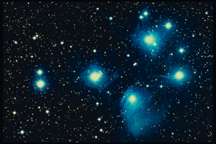
Remember the story of Job? Job was extremely wealthy — enjoying a wonderful family. Then tragedy struck. He lost his wealth. His children were killed and his wife deserted him. Then Job lay in excruciating pain, covered with sores from head to toe. All this was too much for Job. He accused the Lord of being unjust. God didn’t answer Job’s accusation directly. He merely raised questions concerning the wonders of His creation. Three of these questions found in Job 38:31, 32, illustrate the dynamic logic conveyed in God’s questions.
Canst thou bind the sweet influences of Pleiades, or loose the bands of Orion? Canst thou guide Arcturus with his sons?
"Canst thou . . . loose the bands of Orion?" Garrett P. Serviss, the noted astronomer, wrote about the bands of Orion12 in his book CURIOSITIES OF THE SKY.
At the present time this band consists of an almost perfect straight line, a row of second-magnitude stars about equally spaced and of the most striking beauty. In the course of time, however, the two right-hand stars, Mintaka and Alnilam, will approach each other and form a naked-eye double; but the third, Alnitak, will drift away eastward so that the band will no longer exist.
In other words, one star is traveling in a certain direction at a certain speed, a second one is traveling in a different direction at a second speed, and the third one is going in a third direction and at a still different speed. Actually every star in Orion is traveling its own course, independent of all the others. Thus, these stars that we see forming one of the bands of Orion are like three ships out on the high seas that happen to be in line at the present moment, but in the future will be separated by thousands of miles of ocean. In fact, all these stars that at the present time constitute the constellation of Orion are bound for different ports, and all are journeying to different corners of the universe, so that the bands are being dissolved.
"Canst thou bind the sweet influence of the Pleiades . . . ?" Notice the amazing astronomical contrast with the Pleiades. The seven stars of the Pleiades are in reality a grouping of 250 suns. Photographs now reveal that 250 blazing suns in this group are all traveling together in one common direction. Concerning this cluster, Isabel Lewis of the United States Naval Observatory tells us: 13
Astronomers have identified 250 stars as actual members of this group, all sharing in a common motion and drifting through space in the same direction.
Elsewhere Lewis speaks of them as "journeying onward together through the immensity of space."
From Lick Observatory came this statement of Dr. Robert J. Trumpler:14
Over 25,000 individual measures of the Pleiades stars are now available, and their study led to the important discovery that the whole cluster is moving in a southeasterly direction. The Pleiades stars may thus be compared to a swarm of birds, flying together to a distant goal. This leaves no doubt that the Pleiades are not a temporary or accidental agglomeration of stars, but a system in which the stars are bound together by a close kinship.
Dr. Trumpler said that all this led to an important discovery. Without any reference whatsoever to the Book of Job, he announced to the world that these discoveries prove that the stars in the Pleiades are all bound together and are flying together like a flock of birds as they journey to their distant goal. That is exactly what God said. "Canst thou bind the sweet influences of Pleiades?" In other words, Canst thou keep them bound together so that they remain as a family of suns?
INCREDIBLE! God's laws of cosmology are loosing or dissolving the constellation Orion. Sometime in the far distant future, Orion will be no more. Conversely, wonder of wonders — every last one of the 250 blazing suns in the Pleiades are ordained of God to orbit together in their symmetrical beauty throughout eternity.
"Canst thou guide Arcturus with his sons?" Garrett P. Serviss wrote:15
Arcturus, one of the greatest suns in the universe, is a runaway whose speed of flight is 257 miles per second. Arcturus, we have every reason to believe, possesses thousands of times the mass of our sun. Think of it! Our sun is traveling only 12 ½ miles a second, but Arcturus is traveling 257 miles a second. Think then of the prodigious momentum this motion implies.
A further observation of Arcturus by Serviss reveals: 16
It could be turned into a new course by a close approach to a great sun, but it could only be stopped by collision head on with a body of enormous mass. Barring such accidents, it must, as far as we can see, keep on until it has traversed our stellar system, whence it may escape and pass out into space beyond to join perhaps one of those other island universes of which we have spoken.
Charles Burckhalter, of the Chabot Observatory, added an interesting note regarding this great sun: 17
This high velocity places Arcturus in that very small class of stars that apparently are a law unto themselves. He is an outsider, a visitor, a stranger within the gates; to speak plainly, Arcturus is a runaway. Newton gives the velocity of a star under control as not more than 25 miles a second, and Arcturus is going 257 miles a second. Therefore, combined attraction of all the stars we know cannot stop him or even turn him in his path.
When Mr. Burckhalter had his attention called to this text in the book of Job, he studied it in the light of modern discovery and made a statement that has attracted worldwide attention:18
The study of the Book of Job and its comparison with the latest scientific discoveries has brought me to the matured conviction that the Bible is an inspired book and was written by the One who made the stars.
The wonders of God’s universe never cease to amaze us. Arcturus and his sons are individual runaway suns that seem to be out of orbit in our galaxy. Traveling at such incredible speeds, why don’t they crash with other suns or planets? Where are they headed? Only God knows. Indeed they are not runaways. They will not crash. Why? God is guiding them.
The Lesson of The Pleiades, Orion, and Arcturus
Few have suffered the multiple tragedies of Job. How could God reach through the enormity of Job’s self-pity? (Job thought God just didn’t care.) In these three questions (Job 38:31, 32) God is in reality saying:
Job, you think I am not concerned about your suffering. Well, let Me ask you these questions. Can you loose the bands of Orion? No, you cannot. But My Divine power will. Some day Orion will no longer exist. Job, can you bind the 250 stars of the Pleiades together in their symmetry of beauty and not have a single one drift off? Only I have this power and wisdom. Can you prevent the runaways — Arcturus and his sons — from colliding as they go dashing out of the Milky Way? No, only My Divine power and wisdom can.
Job, if I am caring for the details of the universe, do you doubt that I not only care for the details of your life, but I have the ability to solve your problems? Trust that there is a good reason I am permitting these tragedies. Remember, Job, I work from the perspective of your eternal welfare.
What an awesome way God chose to tell Job that He was in full control of human affairs, including Job's life!
Some write off the history of Job as Old Testament folklore. Whoever heard of God talking to a man! These are hand-me-down tales! However, the account of Job cannot be gainsaid. Whatever the method of communication used by God, the astonishing facts cannot be refuted. These scientific facts recorded in the book of Job concerning the Pleiades, Orion and Arcturus anticipated scientific discovery by nearly 3,000 years. Scientists only discovered these startling facts in the Twentieth Century, yet they were recorded in the book of Job nearly 3000 years ago. What an awesome confirmation of the Bible! Who can doubt the Bible is the inspired word of God? Yes, the book of Job has a powerful, exclusive lesson for modern man. Twentieth Century science has proven God’s Word, the Bible, is true.
Other Sacred Books and the Physical Sciences
The Hindu scriptures, the Vedas and Uparushads, consider that "all the objects and phenomena of nature which man is surrounded, are animate and divine."19 This includes the sun, moon, earth, clouds, rain, rivers, seas and rocks as being alive. Writers of the Buddhist canon also ascribe life to numerous non-living objects— sun, moon, lightning, rainbows, mountains, etc. The Taoist and Confucian writings of China contain similar errors.
The Koran, the scripture of Islam, written 1,500 years after the Hindu scripture, does not contain many of the ancient superstitions. Yet its observations of the universe are seriously flawed. The Koran speaks of seven literal heavens which are solid.20 These heavens contain lamps or stars whose main purpose is to be "darted at the devils."21 Mohammed wrote that "the sun sets in a sea of black mud."22
Which Bible is Inspired by a Living God?
The Judeo-Christian Scripture made scientific observations that were confirmed centuries later by modern science, while the sacred scripture of other world religions merely reflected the scientific superstitions of their culture. How could the Judeo-Christian Scripture anticipate scientific discovery by 3,000 years? The Judeo-Christian Bible was written by men who were inspired by the Creator and God of the Universe — the God of science. Only the Judeo-Christian Bible is the Divine Revelation provided by our infinite Creator to direct us in the path to eternity.
|
|
|
|
|
(heb. {sh y {ayish, "guarda de los osos").
Término astronómico que aparece en Job 9:9 y 38:32 (RV 1909). Las palabras
hebreas no se pueden identificar con certeza. Algunos piensan que representan la
constelación de la Osa Mayor (RVR, BJ, NBE, LPD, DHH); otros, Leo (El León).
"Arcturo", una palabra latinizada tomada del gr. Arktóuros ("cuidador de osos"),
designa la estrella de primera magnitud que parece seguir a la constelación de la Osa
Mayor en su circuito diario por el cielo del hemisferio norte. La evidencia actual indica
que la palabra hebrea traducida por "Arcturo" se refiere a la constelación de la Osa
Mayor, y que sus "hijos" son las estrellas individuales de su constelación
(posiblemente las 7 más brillantes, las que componen el Carro de la Osa Mayor).
Bib.: E. W. Maunder, The Astronomy of the Bible [La astronomía de la Biblia] (Nueva |
|
|
 Primer
Primer
 Anterior
2 a 15 de 90
Siguiente
Anterior
2 a 15 de 90
Siguiente Último
Último
|

